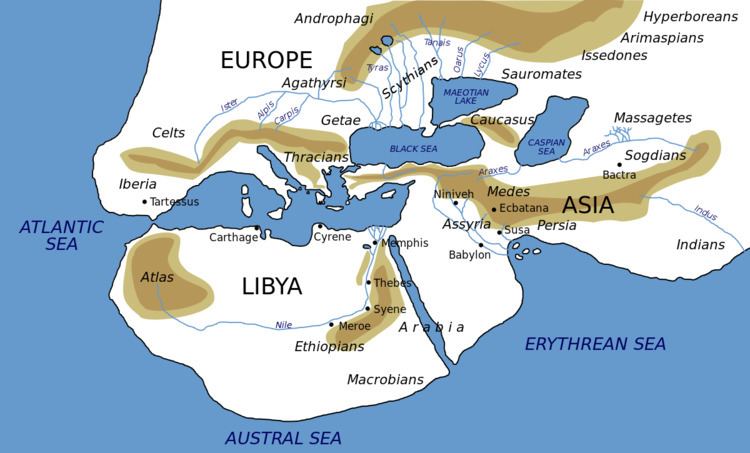 | ||
In ancient Greek geography, the basin of the Indus River (essentially corresponding to the territory of modern Pakistan) was on the extreme eastern fringe of the known world. The first Greek geographer to describe India was Herodotus (5th century BC), who calls it ἡ Ἰνδική χώρη hē Indikē chōrē, after Hinduš, the Old Persian name of the river and the associated satrapy of the Achaemenid Empire. Darius the Great had conquered this territory in 516 BC, and during the 5th century BC, Greek knowledge of India was entirely received by contact with the Persian empire (according to Herodotus 4.44, via Scylax of Caryanda, a Greek explorer who sailed down the length of the Indus in the service of Darius). The Greeks (or Persians) were not aware of the geography of India (or Asia in general) east of the Indus basin. Herodotus in 4.40 is explicit about India being on the eastern fringe of the inhabitable world,
In book 3 (3.89-97), Herodotus gives some account of the peoples of India; he describes them as being very diverse, and makes reference to their dietary habits, some eating raw fish, others eating raw meat, and yet others practicing vegetarianism. He also mentions their dark skin colour.
"The tribes of Indians are numerous, and they do not all speak the same language—some are wandering tribes, others not. They who dwell in the marshes along the river live on raw fish, which they take in boats made of reeds, each formed out of a single joint. These Indians wear a dress of sedge, which they cut in the river and bruise; afterwards they weave it into mats, and wear it as we wear a breast-plate. Eastward of these Indians are another tribe, called Padaeans, who are wanderers, and live on raw flesh. [...] There is another set of Indians whose customs are very different. They refuse to put any live animal to death, they sow no corn, and have no dwelling-houses. Vegetables are their only food. [...] All the tribes which I have mentioned live together like the brute beasts: they have also all the same tint of skin, which approaches that of the Ethiopians. [...] Besides these, there are Indians of another tribe, who border on the city of Caspatyrus, and the country of Pactyica; these people dwell northward of all the rest of the Indians, and follow nearly the same mode of life as the Bactrians. They are more warlike than any of the other tribes, and from them the men are sent forth who go to procure the gold. For it is in this part of India that the sandy desert lies. Here, in this desert, there live amid the sand great ants, in size somewhat less than dogs, but bigger than foxes. [...]" (trans. Rawlinson)In 3.38, Herodotus mentions the Indian tribe of the Callatiae for their practice of funerary cannibalism; in a striking illustration of cultural relativism, he points out that this people is just as dismayed at the notion of the Greeks practicing cremation as the Greeks are at that of eating their dead parents. In book 7 (7.65,70,86,187) and in 8.113 Herodotus describes the Indian infantry and cavalry employed in Xerxes' army.
Only after the conquests of Alexander the Great and the emergence of the Indo-Greek kingdoms did the Mediterranean world acquire some first-hand knowledge about the region (conversely, Indians also became aware of the existence of the Greeks during this period, naming them Yavana in Sanskrit). By the 3rd century BC, Eratosthenes recognized "India" as terminating in a peninsula (reflecting a first grasp of the geography of the Indian Subcontinent) instead of just placing it generically at the far eastern end of "Asia". Eratosthenes was also the first Greek author to postulate an island Taprobane at the far south of India, later becoming a name of Sri Lanka. European knowledge of the geography of India did not become much better resolved until the end of Antiquity, and remained at this stage throughout the Middle Ages, only becoming more detailed with the beginning of the Age of Sail in the 15th century.
